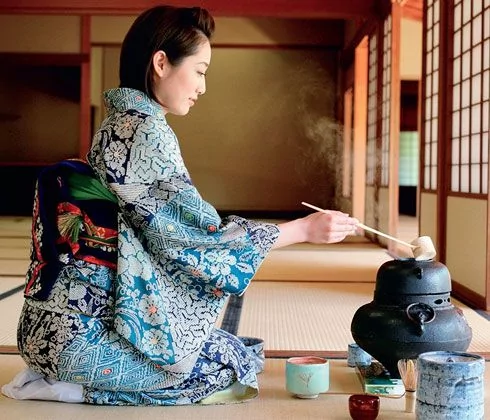Free shipping from $55
Japan: Cha No Yu
In Japan, tea has a very important cultural dimension. More than just an art of good living, it is a cult founded on the adoration of Beauty amidst the banalities of everyday existence. This philosophy has translated itself into the form of an extremely circumscribed ceremony, which takes place in a specific place and every gesture must be strictly followed.

A maximum of five people perform the ceremony, which is held in a pavilion including a tea room and a preparation room, usually located in a specific shady part of the garden. Smaller than traditional tearooms this pavilion should give the impression of genteel poverty since asceticism conveys for the Japanese people the essence of true beauty.
This philosophical ceremony, developed towards the end of the 15th century under the influence of Zen Buddhism, invites man to purify himself by uniting with nature. This is why the walkway leading to the pavilion is lined with trees and flowers, allowing the visitor to reach the first stage of meditation. Nothing else, moreover, is left to chance: decor, food, conversational subjects, etc. Great respect is given to the geishas who are perfectly in control of even the smallest detail of the ceremony.
Firstly, a light meal is served, followed by a short pause. Then comes the Goza Iri, the central moment of the ceremony during which first a thick tea is served - Koicha - then a light one - Usucha. Various cleansing rituals and courtesies take place until the host hits a gong five times. After a series of meticulous gestures, he pours into a bowl three spoonfuls of Matcha per guest, adds a ladleful of hot water and beats it with a bamboo whisk until a thick liquid has been produced. The bowl is placed next to the hearth and the guest of honour approaches on his knees. He then takes three sips and, after the first one offers his compliments on the taste of the tea. He then dries the place where his lips touched the bowl, with the Kaishi paper that he brought with him, and passes the bowl to the second guest who proceeds in the same way and so forth. The last person gives the bowl back to the first guest, who hands it over to the host.
The different stages of the Cha No Yu ceremony have been of the utmost importance in the development of Japanese architecture, gardening techniques, landscaping methods, its china and floral art. Each step involves aesthetic awareness and compliance in very different areas. For example, it's about valuing the tools necessary for the ceremony: the bowl, the box, the ladle, the whisk; these are often true works of art. But it is also about knowing how to relish their decorative settings, such as the Kakemono, a vertical painting on a roller, the Chabana, a flower arrangement designed for the occasion or even the harmony played out by the slopes of the teahouse roofs.
Furthermore, the meticulous etiquette followed during this ceremony has fundamentally influenced the conduct and social graces of Japanese people. To take an interest in this ancient art, which is designed to give grace and good manners to those who practise it, is one of the keys to understanding Japanese society.